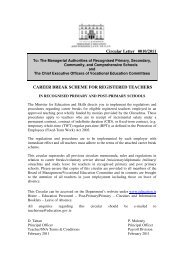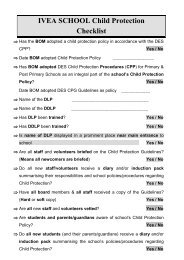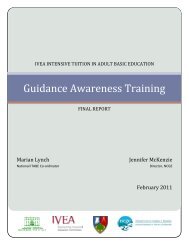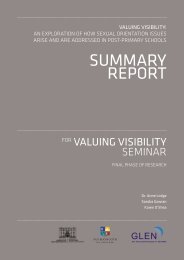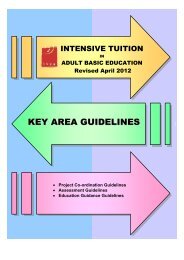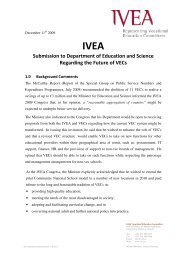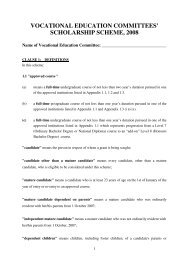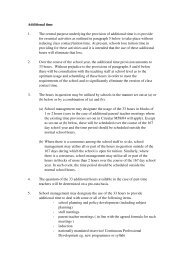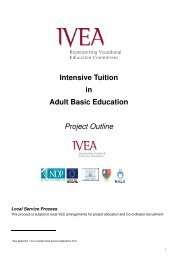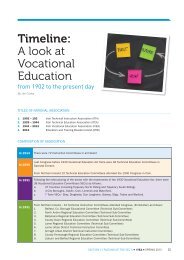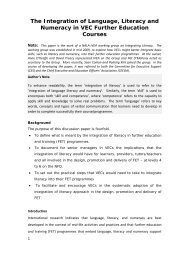Download File - IVEA
Download File - IVEA
Download File - IVEA
You also want an ePaper? Increase the reach of your titles
YUMPU automatically turns print PDFs into web optimized ePapers that Google loves.
the situation of those who experience inequality.[S. 4.3 Intercultural and Anti-Racism Policy]<strong>IVEA</strong> recommends that intercultural and anti-racist strategies be situatedwithin the overall equality framework of the educational institution.<strong>IVEA</strong> recommends that the following initiatives be undertakenfor all staff:• Anti-racist and cultural awareness training programmes bedeveloped and delivered to all staff (managers, tutors, supportstaff, frontline staff) in consultation with organisations withexpertise who are already active in this area of work, andinvolving target groups in the design and delivery of programmes;• Specific training programmes for specialist areas be developede.g. women, survivors of torture;• Information sessions be provided for staff on asylum policyand process, working with groups with special needs etc.;• Accredited training programmes be developed for staff whichcould be undertaken on a modular basis;• Translation of all documentation into key languages.CHAPTER 5[S. 5.2 Initial Enrolment and Assessment]When enrolling a student, specific information is required to help organise andplan provision. Questions should be asked in a non-threatening environment.Assessment is vital to understand the educational background and Englishlanguage needs of the prospective students. Assessment should be aboutvaluing previous experience and additional languages and cultures. Thereare currently no initial educational or language assessment tools for adult andfurther education. Providers currently use a range of assessment tools (formalELT and self-made tools).The <strong>IVEA</strong> recommends that an assessment framework be developedto assess and establish:• Educational background;• Listening, speaking, reading and writing skills in English;• Study skills;• First language literacy;• Numeracy.[S. 5.2.1 Assessment/Enrolment of Minority Linguistic Learners:Guidelines & S. 5.2.2 Sample Enrolment Forum for MinorityLinguistic Learners]<strong>IVEA</strong> recommends that educational institutions use the guidelines forenrolment and assessment of bilingual/ESOL students [section 5.2.1] andtake on board the sample enrolment form for bilingual/ESOL students [section5.2.2] which has been adapted by <strong>IVEA</strong> from sections devised by JessicaWanzenböck 49 , CDVEC for <strong>IVEA</strong>’s Pilot Framework for Educational Provisionfor Bilingual Learners including Asylum Seekers and Refugees; Volume II:Second Level (2004).[S. 5.3 Identifying the needs of the learner]Having established a profile of the learner, the educational institution should,in consultation with the learner, the course co-ordinator and the guidancecounsellor, make a decision on the most appropriate course for the learner.The learner should be clearly aware of the course progression, transfer andaccreditation paths.CHAPTER 6[S. 6.2 ESOL]<strong>IVEA</strong> recommends that:• English for Speakers of Other Languages (ESOL) methodology beused in catering for the English language and literacy needs of minoritylinguistic learners.• Accredited ESOL teacher-training which takes account of the specificcircumstances of minority linguistic learners’ needs be devised anddelivered. To implement this recommendation, a National ESOLCo-ordinating Committee should be established by the Department ofEducation and Science immediately.• Opportunities to learn first languages as part of Further Educationshould be made available as part of mainstream PLC programmes.• Dual textbooks incorporating English and an additional language(e.g. English and Russian, English and Romanian etc.) should bemade available.• Signs etc. translated into key languages should feature prominently inthe educational institution.• Further Education teachers need to be trained in language-awareteaching methods.• Content-based language teaching materials are required for thedevelopment of pre-vocational language.[S. 6.3 Literacy for ESOL Learners]<strong>IVEA</strong> recommends that:• Students with first language literacy needs be identified early on throughassessment [refer to section 5.2];• Separate tuition should be organised for developing reading and writingskills for learners with literacy/basic education needs. Educationalinstitutions need a dedicated room for small group teaching;• A clear progression route be developed for learners using the newNational Qualifications Framework;• Materials be developed to support first language literacy;• The possibility of bilingual literacy programmes be examined;• A specific programme to cater for the basic education needs of minoritylinguistic learners be developed as a matter of urgency.[S. 6.4 Standard English for African English Speakers]<strong>IVEA</strong> recommends that training and materials are devised for minoritylinguistic learners. It is recommended that educational institutions offer specificclasses and workshops to support the development of Standard English forAfrican English speakers.[S. 7.3.2 Work Experience in the context of MinorityLinguistic Students]In considering work experience in the context of minority linguistic learners it isimportant to bear in mind the following points:49The guidelines and sample enrolment form are based on Hall Deryn’s 2001 publication Assessing the Needs of Bilingual Pupils – Living in Two Languages (David Fulton Publishers, London: 2001).37



